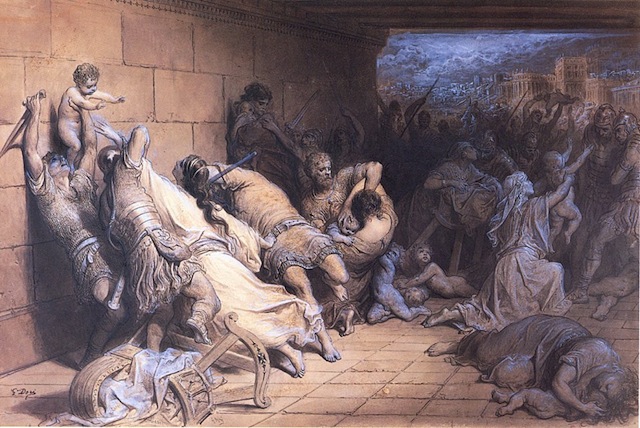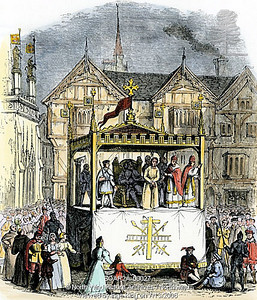The Martyrdom of the Holy Innocents, painting by Gustave Dore, 1888Conventry Carol & The Slaughter of the Innocents
One of the factors contributing to the demise of the 16th Century English Reformation was the regional “mystery plays”: local pageant cycles in which the common folk performed dramatized Biblical stories. (The York cycle is the most famous.) Many of the surviving texts derive from the flowering of Middle English in the wake of Chaucer and Langland, and are of a very high literary quality.
Pageant wagon (note the trade symbol)The performances were mounted by various guilds and professions, so the coopers would dramatize the Fall of Man, the shipwrights the building of the ark, the tile-thatchers the Nativity, the butchers the Crucifixion (yes, really), and so on. The plays were done on “pageant wagons”: essentially horse-drawn sets not unlike parade floats. It was a way for a largely illiterate population to learn their Bible stories, but it smacked too much of popery so the authorities forcibly repressed the practice. Fortunately, we live in more enlightened times.
One cycle of plays was the cycle for Coventry, and the play put on by the shearmen and tailors was the slaughter of the innocents, depicting the slaughter of young boys in Bethlehem as described in the Gospel of St. Matthew 2:16-18.
16 Then Herod, when he saw that he was mocked of the wise men, was exceeding wroth, and sent forth, and slew all the children that were in Bethlehem, and in all the coasts thereof, from two years old and under, according to the time which he had diligently inquired of the wise men.
17 Then was fulfilled that which was spoken by Jeremiah the prophet, saying,
18 In Rama was there a voice heard, lamentation, and weeping, and great mourning, Rachel weeping for her children, and would not be comforted, because they are not.
When Hamlet refers to an actor who “out-Herods Herod,” he’s talking about the over-emoting brought to the villainous role of Herod by amateur actors in these pageants.
After the slaughter of the innocents in the play, the women mourn for their lost children by singing them a final lullaby, and this is the origin of “Coventry Carol.” The performance below is from the Mediaeval Baebes and is the most delicate and haunting I’ve heard. --by Thomas L. McDonald, December 22, 2012, posted at Patheos.com
Mediaeval Babes, Coventry Carol
Founder/Publisher/Editor: David McGee
Contributing Editors: Billy Altman, Laura Fissinger, Christopher Hill, Derk Richardson
Logo Design: John Mendelsohn (www.johnmendelsohn.com)
Website Design: Kieran McGee (www.kieranmcgee.com)
Staff Photographers: Audrey Harrod (Louisville, KY; www.flickr.com/audreyharrod), Alicia Zappier (New York)
E-mail: thebluegrassspecial@gmail.com
Mailing Address: David McGee, 201 W. 85 St.—5B, New York, NY 10024




